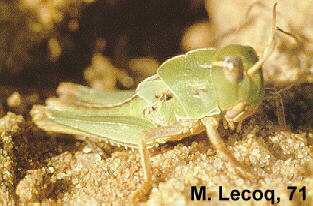Pest locusts
Locusta migratoria (Linné, 1758)
Family : Acrididae
Sub-family : Oedipodinae
Common name : the Migratory locust
 The Migratory locust is widely distributed throughout the Old World, in Africa, south of the Sahara, in the Arabian and Indo-Pakistani peninsulas, Europe and Mediterranean borders, eastern Asia and Australia. The Migratory locust is widely distributed throughout the Old World, in Africa, south of the Sahara, in the Arabian and Indo-Pakistani peninsulas, Europe and Mediterranean borders, eastern Asia and Australia.
However, it is not found in both Americas. There are at least a dozen migratoria sub-species and each is bio-ecologically adapted to the specific ecoclimatic characteristics of their environments.
The Migratory locust seeks heat (optimal temperatures of 20°-25°C), average humidity environments (optimal rainfall of 50-100 mm/month) and colonizes steppes and savannahs with little or no tree cover. It is quite a strict graminivore that is able of causing considerable damage to grain crops and even plantations during outbreak periods. In temperate regions, the Migratory locust undergo embryonic diapause in response to the harsh winters. In such conditions there are 1 or 2 generations per year. This obligatory developmental arrest does not occur in subtropical and tropical subspecies such as Locusta migratoria migratorioides which is able to breed continuously by migrating hundreds of kilometres to encounter ecological conditions that will enable them to survive. This locust can produce 3 to 5 generations per year by utilizing seasonally complementary ecological areas. Hence, their life cycle is rapid when the weather is hot and wet.
The Migratory locust is highly sensitive and able of switching from solitarious to gregarious phase once the critical density threshold is surpassed (estimated at 2 000 adults/hectare in subtropical zones). Phase polymorphism is shown by morphological, anatomical, physiological, ecological and behavioural differences. Solitary adults are characterized by an arched non saddle-shaped pronotum, they are green or brown depending on the seasonal atmospheric humidity levels and males are substantially larger than females. Gregarious males and females are almost the same size with very dark markings. There are 5 to 7 instars in the solitarious phase and only 5 in the gregarious phase. Gregarious forms develop more slowly and produce fewer generations than solitarious forms.
Gregarious Migratory locusts are excellent flyers. Swarms migrate diurnally and are able to reach further and fly longer than solitary locusts which migrate just after nightfall using different wind systems. Phase transformation takes place in outbreak centres which often have more suitable and longer-lasting breeding and densation conditions than elsewhere. In south-Saharan Africa, these outbreak centres are located in moist zones with high residual humidity in the dry season (central Niger River delta in Mali, around Lake Chad and the Blue Nile Region in Sudan). These gregarisation sites are located in enclosed bush clearings in the southwestern part of the island. In Africa, the last serious widespread plague of Locusta migratoria migratorioides took place from 1928 to 1942. Since then, the spatiotemporal rainfall patterns and anthropogenic modifications in the largest and most important West African outbreak zone (central Niger River delta in Mali) have considerably altered the environment to the detriment of this locust. Construction of a dam to control rising and falling floodwaters of the river, development of farming with animal traction and sedentarisation of livestock herds (due to an increased number of wells) have destroyed many Locusta biotopes. Only temporary regional upsurges have occurred which were easily controlled by the national crop protection services.
Migratory locust imagos can be accurately identified according to the following criteria :
General morphology

Size : Males are 42-55 mm long, females are 54-72 mm long.
Overall body colour
Two colours are noted in the solitary phase : green and brown.
 |
In the solitary phase, imagos are generally green or brown with various degrees of black, yellow or brown spots. In natural populations, there are seasonal variations in the percentage of green and brown forms. Green forms predominate in the wet season, with brown forms being more common in the dry season.
In the gregarious phase, imagos are solid yellow with heavy black maculation. |
 |
 Gregarious hoppers are yellow with dark black markings. |
Solitarious hoppers are green or brown. |
Wing colour
Completely transparent, never any colouring.
No prosternal tubercle
|